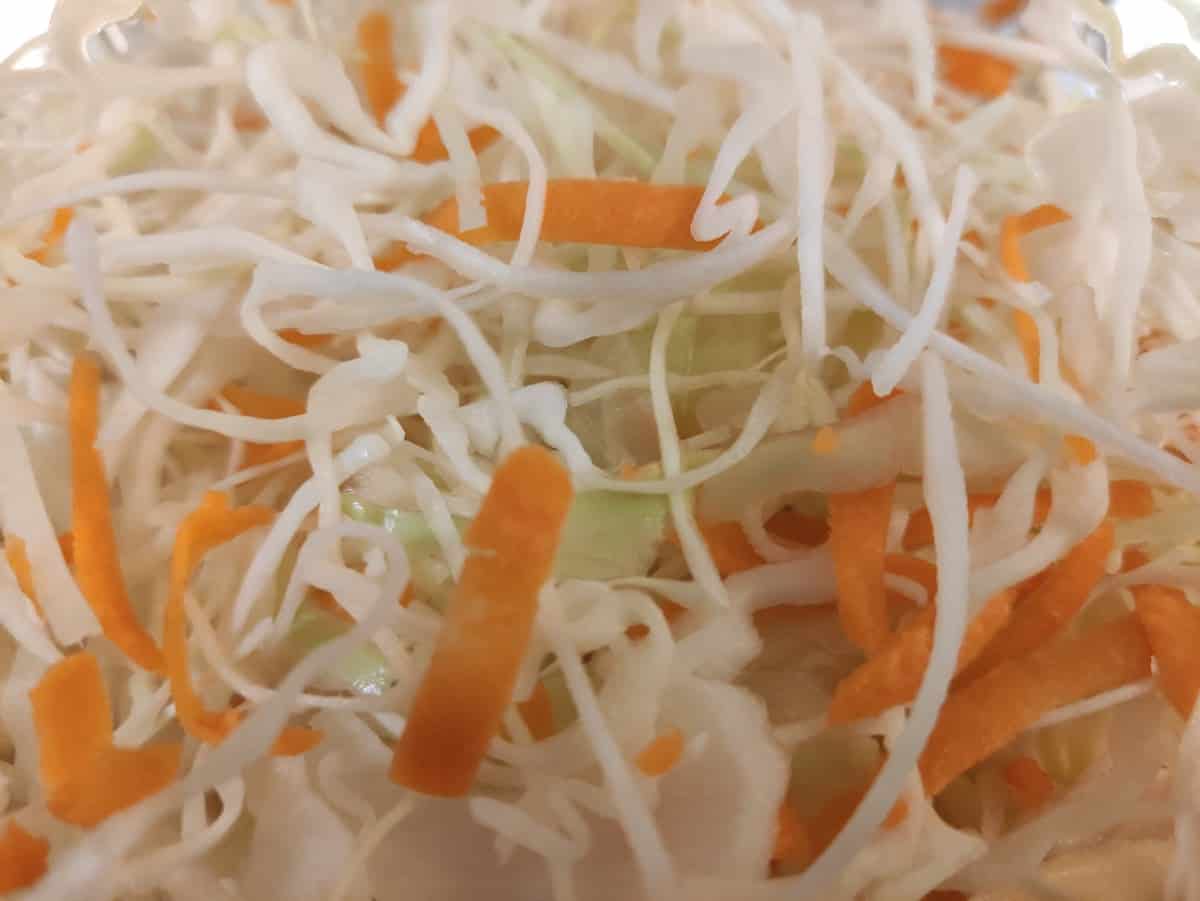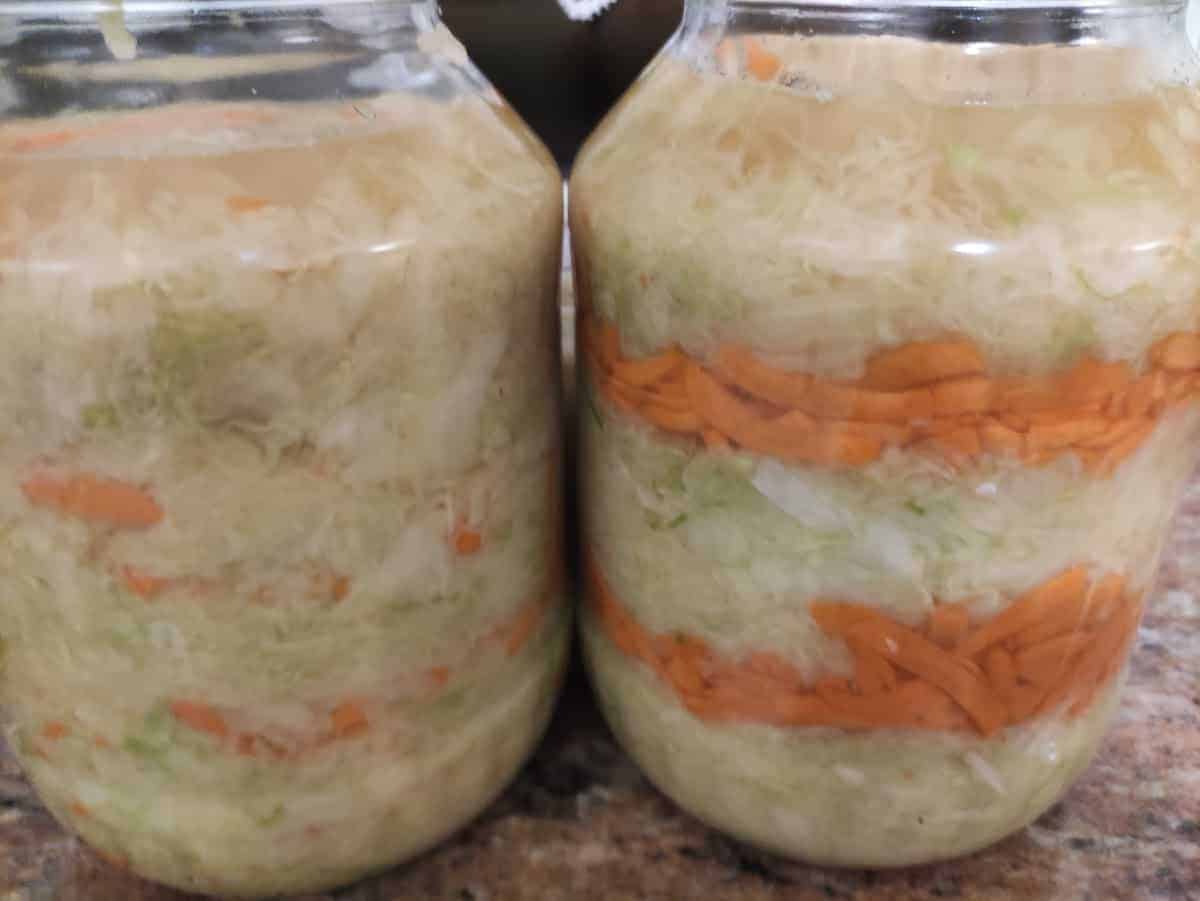Kapusta kiszona is the traditional recipe for Polish sauerkraut. Easy to make, all it requires is time and patience to form the perfect healthy meal!
I remember, when I was a kid, we would make kapusta kiszona in a big barrel. Everyone had different roles. One would remove the top leaves, another would wash the cabbage, and yet another would shred the cabbage.
Next, we would salt the cabbage and then we would press the sauerkraut down and knead it by walking on it with clean feet. This traditional method of making kapusta kiszona is still popular in some places across Poland.
Don’t worry though. There weren’t any chances of catching infections. Anyone who entered the barrel had to wash their feet a few times before going in, just like they do in France while making wine.
If you come across it, it definitely is a must-see process to make real kapusta kiszona.
What Is Kapusta Kiszona?
Kapusta kiszona is the traditional Polish version of sauerkraut, a dish made and loved by every Pole in Poland and across the world. It’s also a national dish in Germany and a popular dish in many Central European countries.
The production of lactic acid bacteria during the fermentation process has a positive effect on the flora of the gut, and hence it’s considered a very healthy dish.
In fact, sauerkraut is so popular that a sauerkraut festival is held in Phelps in the US every year. Another festival called Krautfest is held in Leinfelden-Echterdingen, Germany, and see almost 40,000 visitors every year.
Even in Poland, there’s a cabbage festival in Charsznica every September and if you visit, you’ll find a lot of amazing kapusta on sale here.

Who Invented Kapusta Kiszona?
We love sauerkraut so much. We’d love to think that one of our ancestors invented it. However, sauerkraut is not originally Polish or German or for that matter European.
Kapusta kiszona most probably originated in China and was brought to Europe by the Tartars. History tells that the practice of ‘suan cai’ or fermenting of foods was in practice in China as far back as the 7th century when the Great Wall was being built.

What Other Dishes Is Homemade Polish Sauerkraut Used In?
Kapusta kiszona is a must-have Polish dish. You can eat it solo, cold, or warm. It’s also used as a base for many famous Polish dishes including:
- pierogi with sauerkraut
- krokiety
- Polish Christmas pie (kulebiak)
- Christmas sauerkraut with mushrooms
- paszteciki z kapustą i grzybami
- sauerkraut pancakes (fuczki)
- Polish kapusta with spare ribs
- bigos
- bigos myśliwski
- lazanki
- kwaśnica soup
- Polish fried cabbage
- kapusta with split peas
Tips For Making Kapusta Kiszona At Home
- It is not essential to add carrots.
- You can also add a grated apple to the sauerkraut mix. Apples being pre-biotic in nature, help to get the fermentation process started quicker.
- Make sure you use pure water for the kapusta. Chlorine will inhibit the formation of the bacteria.
- Did you know that sailors once ate kapusta to cure them of the flu?
- Cabbage is a great source of dietary fiber!
- Store the kapusta kiszona jar in a cool dark place till you open it.

FAQs About Homemade Polish Sauerkraut Recipe
Why Do You Not Fill The Jar Completely?
Kapusta will grow and fill the entire jar eventually, that’s why you need to fill only 3/4 of the jar. You don’t want to risk the jar bursting.
What Size Jars Should I Use?
You can use 2 big jars or several small ones. As long as you make sure they are clean and sterilized.
What Illnesses Is Kapusta Kiszona Good For?
Kapusta kiszona is a natural probiotic meal. It’s believed to cure a lot of illnesses, from the common flu to stomach disorders, to constipation and more. But to be sure, check with your doctor or dietitian.
How Long Can The Kapusta Jars Be Stored?
Jars of kapusta kiszona can be stored in a cool dry place for weeks or months. Refrigerate after opening or use within a few days.
Kapusta Kiszona – Homemade Polish Sauerkraut Recipe
Kapusta Kiszona - Homemade Polish Sauerkraut Recipe
Kapusta kiszona is the traditional recipe for Polish sauerkraut. Easy to make, all it requires is time and patience to form the perfect healthy meal!
Ingredients
- 22 lbs (10 kg) of cabbage
- 4.5 lbs (2 kg) of carrot [not necessary]
- 7 oz (200g) of pickling salt
- 2 bay leaves
- 4 allspice berries
Instructions
- Wash and finely chop the cabbage.
- Mix it with salt and leave overnight.
- The next day, drain the cabbage. Leave the cabbage juice for later.
- Peel and grate the carrot. Mix it with cabbage. [Adding carrot is not necessary].
- Sterilize two large (1 galloon) pickling jars.
- Place a bay leaf and 2 allspice berries on the bottom of each jar.
- Take a handful of cabbage inside the jar. Knead to remove all the air from the cabbage.
- Take another handful of cabbage, place it in the jar and knead.
- Repeat the process until the cabbage reaches ¾ of the jar's height. Pour out all the excess water that shows up.
- After you are done kneading the cabbage, cover it with the water you have left. It should reach ½ inch above the cabbage level.

- Twist off the jar and repeat the process with the second jar.
- You can keep the jars in the fridge or in a kitchen. If it stays in a room temperature, it's ready to eat after about 3 weeks. If you keep it in a cold place, you will need to wait for about 2 months.
After you open up the jar, you need to keep it in a fridge.
Notes
- Adding carrot is not necessary.
Recommended Products
As an Amazon Associate and member of other affiliate programs, I earn from qualifying purchases.
Nutrition Information:
Yield:
20Serving Size:
1Amount Per Serving: Calories: 42Total Fat: 0gSaturated Fat: 0gTrans Fat: 0gUnsaturated Fat: 0gCholesterol: 0mgSodium: 48mgCarbohydrates: 10gFiber: 3gSugar: 5gProtein: 2g
These data are indicative and calculated by Nutritionix
Pin For Later:
Did you like this homemade Polish sauerkraut recipe? Let us know in the comments below!





One Response
YES